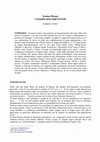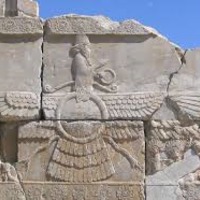Papers by Giampietro Fabbri

UNESCO. Il patrimonio culturale e la diversità: lingue, traduzione e partecipazione, 2024
In this study, some aspects of the linguistic heritage of Romagna are analyzed. In particular, th... more In this study, some aspects of the linguistic heritage of Romagna are analyzed. In particular, the study focuses
on the identification of the cultural contribution of populations that migrated to the area in prehistoric and
protohistoric ages. To this aim, the linguistic heritage is examined with an analysis of the spatial and temporal
distributions of geographic names. The problem of identifying what produced these distributions is
approached as what is known in physics as an inverse problem. The solution is obtained by formulating a
theory based on certain assumptions. In the theory, concepts common in physics are introduced, assimilating
the propagation processes of a culture to diffusive and convective phenomena. The migrations of peoples
who came to Romagna in prehistoric age, and those of their protohistoric descendants, are thus reconstructed.
Cultural exchanges between different peoples are also analyzed and some peculiarities of the languages
spoken are discussed, highlighting the role played in the multilingual context by the frontier populations.

International Journal of Culture and History, 2022
In this study, some of the most relevant names occurring in the myths concerning the foundation o... more In this study, some of the most relevant names occurring in the myths concerning the foundation of Rome are analysed in order to obtain confirmations or new informations on the origin of the city and its early inhabitants. In particular, the role of Latin and Etruscan tribes in populating the Roman hills is investigated. The contribution of these peoples is considered together with that of other ancient peoples who have been recognised as migrated in ancient Italy mainly during the II millennium BC, according to a recent diffusion model based on the time and space distributions of ancient and current geographical names and ethnonyms. The analysis of the names reported in the foundation myths leads to the conclusion that Latins originally were a people of the Etruscan federation as well as the peoples who inhabited Volsinii and Felsina at the beginning of the I millennium BC. Moreover, the name of Romans originally was an exonym by which Latins called other peoples of the Etruscan confederation and later was extended to indicate all the inhabitants of Rome. Lastly, most of the names of the mythological founders of Rome or their ancestors are eponyms of the peoples that populated ancient Lazio and contributed to the rise of Rome.
In the first part of this study the name *Suparsthas is reconstructed and proposed for the ancest... more In the first part of this study the name *Suparsthas is reconstructed and proposed for the ancestors of the peoples speaking the Proto-Indo-European language and their relatives. Moreover, the name *Swagwautas and its variants are recognised as endonyms of Proto-Indo-Europeans. By analyzing the ethnonyms of the descendant peoples and the historical attestations on them, traces of the customs and religion of *Suparsthas and *Swagwautas are highlighted. Lastly, the early migrations of the descendant peoples in Asia and Europe are reconstructed until the beginning of the second millennium BC.

Annals of Global History, 2020
In this study, two of the most important Sabine deities, Sabus and Vacuna, are considered. Their ... more In this study, two of the most important Sabine deities, Sabus and Vacuna, are considered. Their names are analysed and derived from eponyms which are characteristic of Proto-Scythian global culture. Moreover, the ethnogesesis of the sabine people is investigated in order to understand the origin of the deities, their cults, and their names. To this aim, the peopling of ancient Central Italy is studied by considering the ancient sources and the results of a diffusion model based on the time and space distributions of ancient and current geographical names and ethnonyms. The migrations to Italy of peoples contributing to the population of Central Italy are then distinguished and changes in people names are demonstrated. On the basis of ethnogenesis of the Sabine people, the customs related by ancient sources are explained and the relationships between the Sabine eponymous deities and those of other Italic peoples are highlighted. In particular, the relatioships with Feronia and Bellona goddesses are analyzed. These deities are recognized as the eponymous goddesses of some Proto-Etruscan tribes.

Annals of Global History, 2019
This study focuses on the Etruscan case and develops a recent diffusion theory based on the analy... more This study focuses on the Etruscan case and develops a recent diffusion theory based on the analysis of the time and space distributions of ancient ethnonyms and toponyms integrated with historical attestations. Estruscans are considered as a confederation of tribes belonging to two distinct lineages descending from *Thyrgwaunas, speaking a Proto-Altaic language, and *Gwaulgwaunas, speaking a Proto-Indo-European one. Such a confederation had been known in the Aegean area as “the Mixed People”, i.e. *Mykgwaunas (whence Mygdonianians and Mycenaeans). The descendants of the two lineages are recognised in Italy and distinguished as Tyrsinians and Volsinians, according to the terminology of Greek and Roman historians. The phonetic changes in the names of the tribes with respect to the original common forms are analysed. The diffusion of Tyrsinian and Volsinian tribes along the Italic peninsula is then investigated by analysing the origins of the main Etruscan and related cities.
Global Journal of Archaeology & Anthropology, 2018
In this study the origins of the city of Bologna are investigated by analysing the geographical n... more In this study the origins of the city of Bologna are investigated by analysing the geographical names of its area and comparing them to similar toponyms and ethnonyms in Italy and in Eurasia. In this way, traces of the ancient peoples that migrated to the Italian peninsula are detected. In particular, the role of Proto-Scythians, Proto-Umbrians, and Proto-Etruscans in populating the Padanian Valley and Bologna area are analysed. To this aim, archaeological finds in Bologna territory are taken into consideration. The names of the early peoples that inhabitated the urban area of Bologna are then reconstructed and the peoples themselves are put in relationship with the phases of the ancient city.
Journal of Ancient History and Archaeology, 2018
In the second part of this study the main migrations of the peoples descending from *Suparsthas a... more In the second part of this study the main migrations of the peoples descending from *Suparsthas and *Swagwautas are reconstructed in Asia and Europe from the second millennium BC to the tenth AD. The role of Etruscan relative peoples in the evolution of Indo-European nations and languages is investigated and highlighted.
Journal of Ancient History and Archaeology, 2017
In the first part of this study the name *Suparsthas is reconstructed and proposed for the ancest... more In the first part of this study the name *Suparsthas is reconstructed and proposed for the ancestors of the peoples speaking the Proto-Indo-European language and their relatives. Moreover, the name *Swagwautas and its variants are recognised as endonyms of Proto-Indo-Europeans. By analyzing the ethnonyms of the descendant peoples and the historical attestations on them, traces of the customs and religion of *Suparsthas and *Swagwautas are highlighted. Lastly, the early migrations of the descendant peoples in Asia and Europe are reconstructed until the beginning of the second millennium BC.

Scienze & Ricerche, 2017
In this study an interpretation is proposed for the name of the Etruscan city of Kainua, whose re... more In this study an interpretation is proposed for the name of the Etruscan city of Kainua, whose remains have been brought to light in Marzabotto, in the province of Bologna. To this aim, the origins of Etruscans have been recalled together with their characteristic of being actually a confederation of peoples belonging to two distinct lineages descending from *Thyrgwaunas, speaking a Protoaltaic language, and *Gwaulgwaunas, speaking a Proto-Indo-European one. Such a confederation was known in the Aegean area as “the mixed people”, i.e. *Mykgwaunas (Mygdones and Mycenaeans). The descendants of the two lineages are thus recognized in Italy and distingushed as Tyrsini and Volsini, according to the terminology of Greek and Roman historians. Then tyrsinian, volsinian and mixed origins are analyzed for the main Etruscan cities, including Kainua. For this latter, even on the basis of archaeological finds, a Sabatia/Sabine and Umbrian origin is assumed, followed by a volsinian re-foundation and a subsequent tyrsinian-volsinian one. The name of Kainua is then brought back to the one shared by the ancestors of Umbrian (*Gwaunas *Hubaras), Sabines (*Swagwaunas), Volsini and Tyrsini, i.e. *Gwaunas, transformed through to the phonetic changes of the Umbrian language into *Kainas, and derived into Kainua with the addition of the characteristic tyrsinian patronymic desinence -ua: “the city of Kainas”. Lastly, Kainua is supposed to have been also known as “city of the mixed people”, namely *Mysena (< *Mykgwaunas), whence the current name of the place.
Http Dx Doi Org 10 1080 01457639808939935, Apr 27, 2007
ABSTRACT In the present work the problem of optimizing the lateral profile of longitudinal fins i... more ABSTRACT In the present work the problem of optimizing the lateral profile of longitudinal fins in annular ducts in order to enhance the heat transfer under laminar coolant flow conditions is studied. The velocity and temperature distributions on the annular duct cross section are determined with the help of a finite-element model, and a global heat transfer coefficient is calculated. A polynomial lateral profile is proposed for the fins, and the geometry is optimized in order to make the transferred heat as high as possible for a given amount of material and for a given hydraulic resistance. Lastly, the optimum fin profiles obtained for different situations by means of a genetic algorithm are shown.
ABSTRACT In the present work the problem of optimizing the geometry of internally finned tubes in... more ABSTRACT In the present work the problem of optimizing the geometry of internally finned tubes in order to enhance the heat transfer under laminar flow conditions is studied. The velocity and temperature distributions on the finned tube cross-section are determined with the help of a finite element model, and a global heat transfer coefficient is calculated. A polynomial lateral profile is proposed for the fins and the geometry is optimized in order to make the heat transferred per unit of tube length or surface as high as possible for a given weight and for a given hydraulic resistance. Finally, the optimum fin profiles obtained by means of a genetic algorithm are shown for different situations.
Heat Transfer Engineering, Nov 1, 2000
ABSTRACT In the present work, noncondensable contaminant accumulation in tubes of single-pass, mu... more ABSTRACT In the present work, noncondensable contaminant accumulation in tubes of single-pass, multiple-row, cross-flow condensers is investigated. A mathematical model of condensation in such heat exchangers is proposed, which considers changes along the tubes in the saturation temperature, coolant velocity, and heat transfer effectiveness. The model equations are solved with an original algorithm. The vapor distribution, the global effectiveness of the condenser, and the pressure drop between the inlet and outlet plena are determined under different working conditions.
International Journal of Heat and Mass Transfer, Jun 1, 1997
In the present work a genetic algorithm is proposed in order to optimize the thermal performance?... more In the present work a genetic algorithm is proposed in order to optimize the thermal performance?, of finned surfaces. The bidimensional temperature distribution on the longitudinal section of the fin is calculated by resorting to the finite elements method. The heat flux dissipated by a generic profile fin is compared with the heat flux removed by the rectangular profile fin with the same length and volume. The genetic algorithm is then applied to the case of polynomial profile fins, in order to determine the polynomial parameter values which optimize the fin effectiveness. The optimum profile is finally shown for different polynomial orders. 0 1997 Elsevier Science Ltd. All rights reserved.
International Communications in Heat and Mass Transfer, Jul 1, 2005
In this work the analysis of the heat transfer in the entrance region of a channel composed by a ... more In this work the analysis of the heat transfer in the entrance region of a channel composed by a corrugated profile and a flat wall is presented. The laminar and incompressible flow of a Newtonian fluid is assumed inside the channel, and an uniform heat flux is imposed on ...

Proceedings of the 16th IFAC World Congress, 2005, 2005
ABSTRACT In the present work the cooling of a high power electronic device is studied. The device... more ABSTRACT In the present work the cooling of a high power electronic device is studied. The device is in contact with a heat dissipator crossed by air. The air motion through the dissipator is forced by a fan whose supplied power is to be minimized. A finite element dynamic model of the dissipator is firstly created, taking geometrical and physical properties into account as well as steady state experimental data. A simplified model is then obtained, which reproduces the time pattern of the maximum dissipator temperature as a response of the thermal flux removed from the electronic device and of the mass flow rate of the air. Afterwards, the simplified model is utilized to build a control system which allows the electronic device to be correctly cooled at minimum air ventilation power during transition to steady states. Genetic algorithms are used to find the parameters of the finite element model and of the control system. Some functioning conditions of the electronic device are lastly considered and discussed.

Cardioscience
Arterioles and microvascular venules often show rhythmic spontaneous changes in diameter, called ... more Arterioles and microvascular venules often show rhythmic spontaneous changes in diameter, called vasomotion. In this study, we analyze the possibility that vasomotion originates from the activity of the local myogenic mechanism. This analysis uses an original mathematical model of the peripheral circulation. The peripheral vascular bed has been represented as a series of three consecutive segments, each characterized by its value of vascular resistance per unit weight of tissue. The internal radius of the vessels in the last two segments, and hence their hydraulic resistance, has been assumed to be affected by the local myogenic response of the vascular smooth muscle. This dependence has been reproduced using the Laplace law. Both the static and dynamic (i.e. rate-dependent) components of the myogenic response have been included in the model, in accordance with recent experimental results. Simulations demonstrate that rhythmic, self-sustained oscillations can develop when the dynami...
International Journal of Heat and Technology










Uploads
Papers by Giampietro Fabbri
on the identification of the cultural contribution of populations that migrated to the area in prehistoric and
protohistoric ages. To this aim, the linguistic heritage is examined with an analysis of the spatial and temporal
distributions of geographic names. The problem of identifying what produced these distributions is
approached as what is known in physics as an inverse problem. The solution is obtained by formulating a
theory based on certain assumptions. In the theory, concepts common in physics are introduced, assimilating
the propagation processes of a culture to diffusive and convective phenomena. The migrations of peoples
who came to Romagna in prehistoric age, and those of their protohistoric descendants, are thus reconstructed.
Cultural exchanges between different peoples are also analyzed and some peculiarities of the languages
spoken are discussed, highlighting the role played in the multilingual context by the frontier populations.
on the identification of the cultural contribution of populations that migrated to the area in prehistoric and
protohistoric ages. To this aim, the linguistic heritage is examined with an analysis of the spatial and temporal
distributions of geographic names. The problem of identifying what produced these distributions is
approached as what is known in physics as an inverse problem. The solution is obtained by formulating a
theory based on certain assumptions. In the theory, concepts common in physics are introduced, assimilating
the propagation processes of a culture to diffusive and convective phenomena. The migrations of peoples
who came to Romagna in prehistoric age, and those of their protohistoric descendants, are thus reconstructed.
Cultural exchanges between different peoples are also analyzed and some peculiarities of the languages
spoken are discussed, highlighting the role played in the multilingual context by the frontier populations.